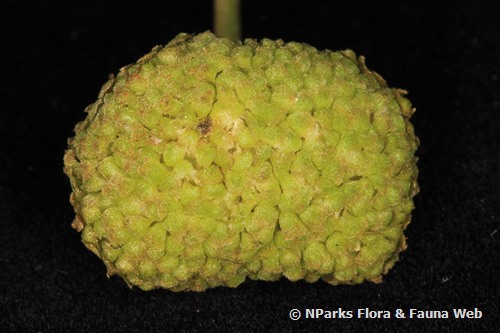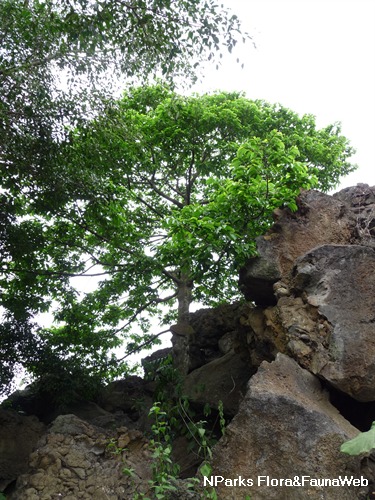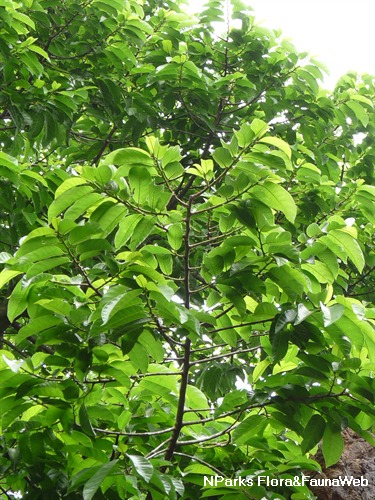
Back
Antiaris toxicaria Lesch.
| Family Name: | Moraceae |
| Synonyms: | Antiaris macrophylla, Antiaris africana, Antiaris welwitschii |
| Common Name: | Upas tree, Sacking tree, Ipoh Tree, 见血封喉 |
Name
Classifications and Characteristics
| Plant Division | Angiosperms (Flowering Seed Plants) |
|---|---|
| Plant Growth Form | Tree (Big (>30m), Medium (16m-30m)) |
| Mode of Nutrition | Autotrophic |
| Maximum Height | 45 m |
Biogeography
| Native Distribution | Peninsular Thailand, Sumatra (also Enggano, Riau-Lingga Island), Peninsular Malaysia, Singapore, Java, Borneo, the Philippines, Sulawesi, the Moluccas, Solomon Islands, Australia, and Papua New Guinea |
|---|---|
| Native Habitat | Terrestrial |
| Preferred Climate Zone | Tropical |
| Local Conservation Status | Native to Singapore (Critically Endangered (CR)) |
Description and Ethnobotany
| Growth Form | It is a tree, up to 45 m tall and 180 cm in trunk diameter, having grey bark, and occasionally with buttresses when large. |
|---|---|
| Foliage | Its simple, alternate, stalked, hairy leaves have membranous to thinly leathery leaf blades that are oblong-oval, 7.5–20 by 3.6–8.5 cm, with 10–14 pairs of secondary veins. |
| Flowers | It is monoecious (having male and female flowers on the same plant at the leaf axils). Its male flowers are rounded; female flowers are pear-shaped, located on twigs below the leaves. |
| Fruit | Its fruits are pear-shaped, bright red to purple-red, ripening black, and 1.25 cm in diameter. Each fruit contains 1 seed. |
| Habitat | It grows in lowland to lower montane forests up to 1500 m, often near streams. It occurs locally in Bukit Timah Nature Reserve. |
| Etymology | Latin Antiaris, from the Indonesian name for the plant, antijar; Latin toxicarius, poisonous, referring to its latex |
| Ethnobotanical Uses | Others: Its latex is used with sap of Strychnos species in dart and arrow poison, for hunting and warfare purposes. Its latex is also used as fish poison and birdlime. Its timber is sold as terap (usually Artocarpus species wood), used in light construction, furniture, interior finish, pallets, crates, and plywood. Its bark is made into bark cloth after removing the poison by soaking. |
Landscaping Features
| Landscaping | It may be suitable for parks but park managers must be aware of its poisonous sap and plant the tree away from easy public access. |
|---|---|
| Landscape Uses | Parks & Gardens |
| Usage Hazard - Cons | Toxic Upon Ingestion |
Plant Care and Propagation
| Light Preference | Full Sun, Semi-Shade |
|---|---|
| Water Preference | Lots of Water, Moderate Water |
| Plant Growth Rate | Moderate |
| Rootzone Tolerance | Well-Drained Soils |
| Propagation Method | Seed |
Foliar
| Foliage Retention | Deciduous |
|---|---|
| Mature Foliage Colour(s) | Green |
| Foliar Arrangement Along Stem | Alternate |
| Foliar Attachment to Stem | Petiolate |
| Foliar Venation | Pinnate / Net |
Floral (Angiosperm)
| Flower Location | Axillary |
|---|
Fruit, Seed and Spore
| Seed Quantity Per Fruit | Few (1-5) |
|---|
Image Repository
Others
| Master ID | 29235 |
|---|---|
| Species ID | 3544 |
| Flora Disclaimer | The information in this website has been compiled from reliable sources, such as reference works on medicinal plants. It is not a substitute for medical advice or treatment and NParks does not purport to provide any medical advice. Readers should always consult his/her physician before using or consuming a plant for medicinal purposes. |




_lowres.jpg)
_lowres.jpg)
_lowres.jpg)
_lowres.jpg)